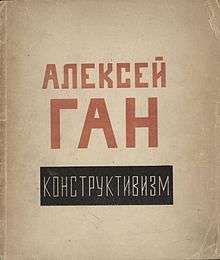Hans Richter (artist)
Hans Richter (6 April 1888 – 1 February 1976) was a German painter, graphic artist, avant-gardist, film-experimenter and producer.[1] He was born in Berlin into a well-to-do family and died in Minusio, near Locarno, Switzerland.
Hans Richter | |
|---|---|
| Born | 6 April 1888 |
| Died | 1 February 1976 (aged 87) |
| Occupation | Painter, graphic artist, avant-gardist, film-experimenter, producer |
| Years active | 1914–1961 |
Germany
Richter's first contacts with modern art were in 1912 through the "Blaue Reiter" and in 1913 through the "Erster Deutscher Herbstsalon" gallery "Der Sturm", in Berlin. In 1914 he was influenced by cubism. He contributed to the periodical Die Aktion in Berlin.[2] His first exhibition was in Munich in 1916, and Die Aktion published as a special edition about him. In the same year he was wounded and discharged from the army and went to Zürich and joined the Dada movement.
Richter believed that the artist's duty was to be actively political, opposing war and supporting the revolution. His first abstract works were made in 1917. In 1918, he befriended Viking Eggeling, and the two experimented together with film. Richter was co-founder, in 1919, of the Association of Revolutionary Artists ("Artistes Radicaux") at Zürich. In the same year he created his first Prélude (an orchestration of a theme developed in eleven drawings). In 1920 he was a member of the November group in Berlin and contributed to the Dutch periodical De Stijl.
Throughout his career, he claimed that his 1921 film, Rhythmus 21, was the first abstract film ever created. This claim is not true: he was preceded by the Italian Futurists Bruno Corra and Arnaldo Ginna between 1911 and 1912[3] (as they report in the Futurist Manifesto of Cinema),[4] as well as by fellow German artist Walter Ruttmann who produced Lichtspiel Opus 1 in 1920. Nevertheless, Richter's film Rhythmus 21 is considered an important early abstract film.
About Richter's woodcuts and drawings Michel Seuphor wrote: "Richter's black-and-whites together with those of Arp and Janco, are the most typical works of the Zürich period of Dada." From 1923 to 1926, Richter edited, together with Werner Gräff and Mies van der Rohe, the periodical G. Material zur elementaren Gestaltung. Richter wrote of his own attitude toward film:
I conceive of the film as a modern art form particularly interesting to the sense of sight. Painting has its own peculiar problems and specific sensations, and so has the film. But there are also problems in which the dividing line is obliterated, or where the two infringe upon each other. More especially, the cinema can fulfill certain promises made by the ancient arts, in the realization of which painting and film become close neighbors and work together.
USA
Richter moved from Switzerland to the United States in 1940 and became an American citizen. He taught in the Institute of Film Techniques at the City College of New York.[5]
While living in New York City, Richter directed two feature films, Dreams That Money Can Buy (1947) and 8 x 8: A Chess Sonata in 8 Movements (1957) in collaboration with Max Ernst, Jean Cocteau, Paul Bowles, Fernand Léger, Alexander Calder, Marcel Duchamp, and others, which was partially filmed on the lawn of his summer house in Southbury, Connecticut.
In 1957, he finished a film entitled Dadascope with original poems and prose spoken by their creators: Hans Arp, Marcel Duchamp, Raoul Hausmann, Richard Huelsenbeck, and Kurt Schwitters.
After 1958, Richter spent parts of the year in Ascona and Connecticut and returned to painting.[5]
In 1963, he directed the short film "From the Circus to the Moon" on the American artist Alexander Calder.[6]
Richter was also the author of a first-hand account of the Dada movement titled Dada: Art and Anti-Art[7] which also included his reflections on the emerging Neo-Dada artworks.
Filmography
- Rhythmus 21 (1921)
- Rhythmus 23 (1923)
- Rhythmus 25 (1925)
- Filmstudie (1926) with music by Darius Milhaud
- Inflation (1927)
- Vormittagsspuk ("Ghosts Before Breakfast", with music by Hindemith) (1928)
- Zweigroschenzauber (1929)
- The Storming of La Sarraz (written only, directed by Sergei Eisenstein, lost)(1929)
- Rennsymphonie (1929)
- Alles dreht sich, alles bewegt sich (1929)
- Everyday (1929)
- Neues Leben (1930)
- Europa Radio (1931)
- Hallo Everybody (1933)
- Keine Zeit für Tränen (1934)
- Vom Blitz zum Fernsenhbild (1936)
- Dreams That Money Can Buy (1947)
- 8 x 8: A Chess Sonata in 8 Movements (1957)
- Dadascope (1961)
- From the Circus to the Moon (1963)
See also
- Anti-art
- Avant-Garde: Experimental Cinema of the 1920s and 1930s
Notes
- "Magazine Features - Hans Richter, Dada Pioneer". Artnet.com. Retrieved 18 August 2014.
- Haftmann, Werner (1978). Postscript to Dada: Art and Anti-Art. Thames & Hudson. ISBN 0-500-20039-4., p220
- Article on Futurist Cinema Archived 7 October 2002 at the Wayback Machine
- "'The Futurist Cinema' Manifesto, 1916". Unknown.nu. Retrieved 18 August 2014.
- Haftmann, p222
- "Historic Films - Calder Foundation". Retrieved 30 May 2017.
- Richter, Hans (1965). Dada: Art and Anti-Art. Thames & Hudson. ISBN 0-500-20039-4.
References
- Stephen C. Foster, Hans Richter: Activism, Modernism, and the Avant-Garde (Cambridge, MA: MIT Press, 1998). ISBN 9780262561297. OCLC 43718368.
- Mark Purves and Rob McFarland, "Hans Richter: Biography" in: Christoph Bareither et al. (Eds.): Hans Richters "Rhythmus 21": Schlüsselfilm der Moderne.Königshausen und Neumann, Würzburg, 2012. ISBN 382604861X (Article in English).
- Hans Richter, 'Towards a New World Plasticism' in Mary Anne Caws, Manifesto: A Century of Isms (Lincoln, Nebraska and London: University of Nebraska Press, 2001).
Further reading
- Richard Suchenski, "Hans Richter", Senses of Cinema 49 (February 2009).
External links
| Wikimedia Commons has media related to Hans Richter (artist). |
